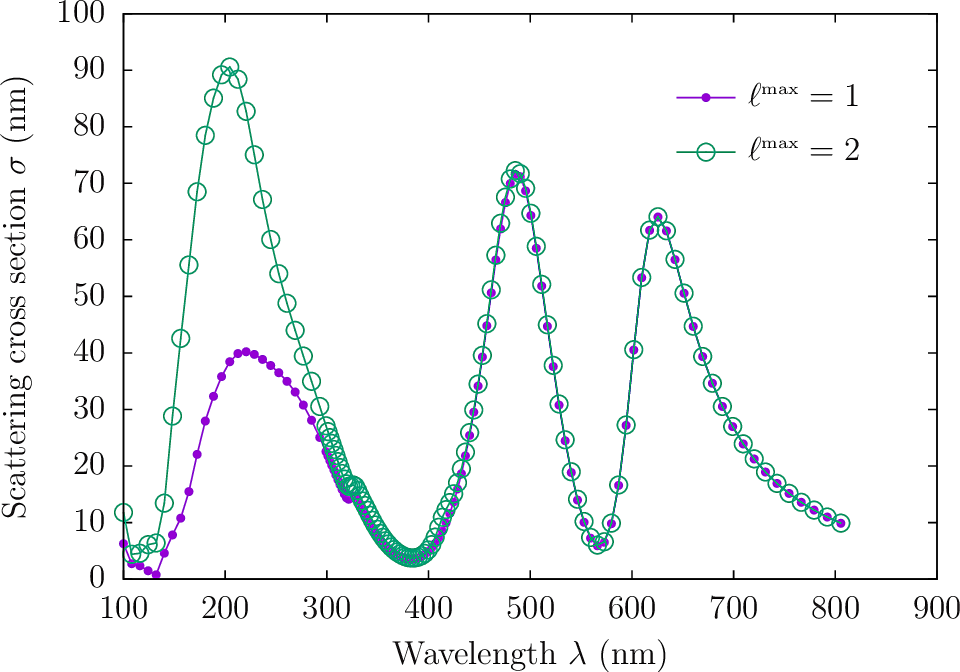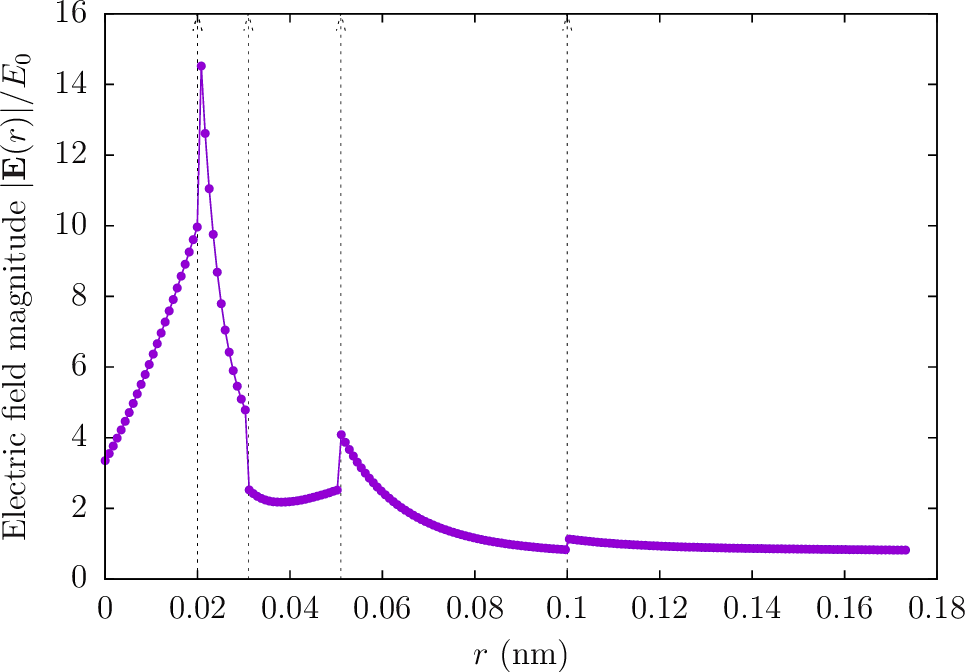========
This is a simple code that implements a generalized Lorenz-Mie theory (GLMT) solver for electromagnetic scattering from spherically-symmetric bodies.
The geometries that may be handled consist of arbitrarily many spherical layers, of arbitrary inner and outer radii, each with arbitrary frequency-dependent permittivity.
The allowed incident fields are
-
plane waves
-
spherical waves
The outputs that may be computed include
-
scattered and total E and H fields at arbitrary points in space
-
scattered and absorbed power, force and torque as obtained by integrating the Poynting vector and Maxwell stress tensor over a bounding sphere surrounding the particle
The theoretical approach and notation used by this code is described in this memo.
Geometries are described by simple text files conventionally given
file extension .GLMT. Blank lines and comments (lines starting with #)
are skipped. Each line specifies a single spherical layer, with
the syntax
RMAX MATERIAL
where
-
RMAXis the outer radius of the layer in microns -
MATERIALis a scuff-em material designation.
Here's a .GLMT file describing a sphere of radius 1 μm with dielectric constant 10:
1.0 CONST_EPS_10
And here's a .GLMT file describing the
doubly-resonant multilayered spherical particle
considered by Hsu et al, "Theoretical criteria for scattering dark states
in nanostructured particles,” Nano Letters 14 2783–2788, May 2014
(http://dx.doi.org/10.1021/nl500340n).
0.100 SiO2
0.051 Silver
0.031 SiO2
0.020 Silver
If one of the layered material regions in your geometry is
actually a void (no material), give it material property VACUUM.
For example, here's a geometry describing the layered particle
above, but with the silver removed to yield just two concentric
spherical shells of SiO2.
0.100 SiO2
0.051 VACUUM
0.031 SiO2
0.020 VACUUM
The repository includes a simple Makefile. You will need to have SCUFF-EM installed before you can build this code.
GLMT-scatter.cc builds to yield a standalone executable
command-line code called GLMT-scatter that implements a subset of the functionality
of [scuff-scatter][scuffScatter]
(see examples below).
The main solver is implemented in the code file GLMTSolver.cc.
The routine CreateGLMTSolver() parses a .GLMT file and constructs
a data structure named GLMTSolver containing all information
the scattering geometry. This structure contains tables of
spherical-wave coefficients which are initialized for a
given frequency and a given incident field by the routine
Solve(). Once Solve() has been called, you can
call post-processing routines:
-
GetFields()computes the scattered and total E and H fields at arbitrary points in space -
GetDSIPFT()computes the power, force, and torque on the body, using the Displaced Surface Integral computational strategy described in this paper.
This example reproduces the "scattering dark state" example involving a nanoparticle consisting of alternating spherical layers of SiO2 and silver, as described in Hsu et al, "Theoretical criteria for scattering dark states in nanostructured particles,” Nano Letters 14 2783–2788, May 2014 (http://dx.doi.org/10.1021/nl500340n).
#!/bin/bash
for LMAX in 1 2
do
ARGS=""
ARGS="${ARGS} --GLMTFile DoublyResonantParticle.GLMT"
ARGS="${ARGS} --OmegaFile Lambda100800nm.OmegaFile"
ARGS="${ARGS} --LMax ${LMAX}"
ARGS="${ARGS} --PWDirection 0 0 1"
ARGS="${ARGS} --PWPolarization 1 0 0"
ARGS="${ARGS} --PFTFile DoublyResonantParticle.L${LMAX}.GLMTPFT"
ARGS="${ARGS} --DSIRadius 0.2"
GLMT-scatter ${ARGS}
done
(The --DSIRadius option controls the radius of the bounding sphere
over which the Poynting vector and Maxwell stress tensor
are integrated to compute powers and forces).
This produces files
DoublyResonantParticle.L1.GLMTPFT and
DoublyResonantParticle.L2.GLMTPFT.
To plot scattered power vs. wavelength in
GNUPLOT, go like this:
gnuplot>
plot 'DoublyResonantParticle.L1.GLMTPFT' u (2*pi/$1):3 t 'LMax=1' w lp pt 7 ps 1, 'DoublyResonantParticle.L2.GLMTPFT' u (2*pi/$1):3 t 'LMax=2' w lp pt 6 ps 2 Here's how to obtain a plot of the spatial variation of the
E-field magnitude. First, put the x,y,z coordinates
of your desired evaluation points into a text file called EvalPoints:
0.00000000 0.00000000 0.00000000
0.00050000 0.00050000 0.00050000
...
0.09950000 0.09950000 0.09950000
0.10000000 0.10000000 0.10000000Then pass this file as the --EPFile option to GLMT-scatter:
ARGS=""
ARGS="${ARGS} --GLMTFile DoublyResonantParticle.GLMT"
ARGS="${ARGS} --Omega 15"
ARGS="${ARGS} --EPFile EvalPoints"
ARGS="${ARGS} --PWDirection 0 0 1"
ARGS="${ARGS} --PWPolarization 1 0 0"
GLMT-scatter ${ARGS}This produces an output file called
DoublyResonantParticle.EvalPoints.GLMTFields.
To plot E-field vs. radius, go like this:
gnuplot> D3(x,y,z)=sqrt($1*$1+$2*$2+$3*$3)
gnuplot> D6(x1,x2,x3,x4,x5,x6)=sqrt(x1*x1+x2*x2+x3*x3+x4*x4+x5*x5+x6*x6)
gnuplot> FILE='DoublyResonantParticle.GLMT'
gnuplot> plot FILE u (D3($1,$2,$3)):(D6($7,$8,$9,$10,$11,$12))
